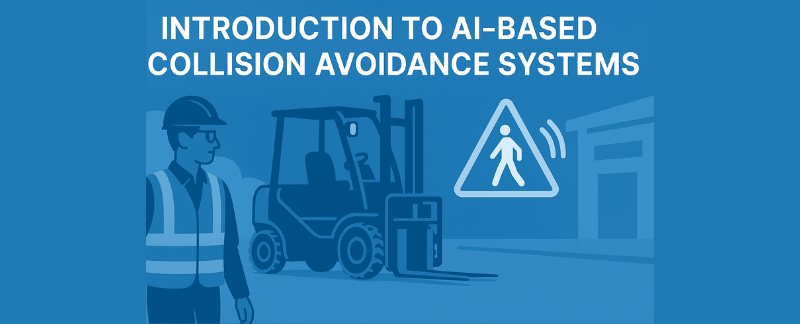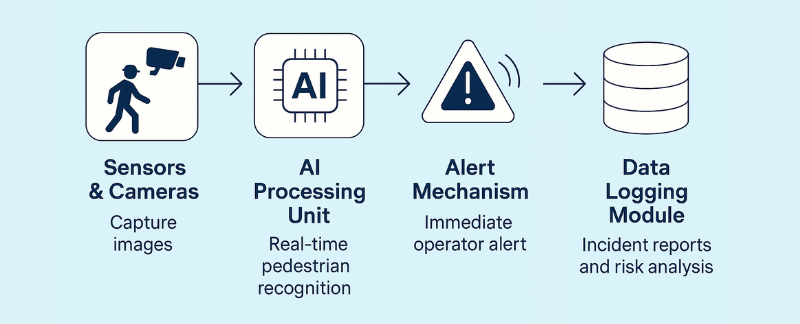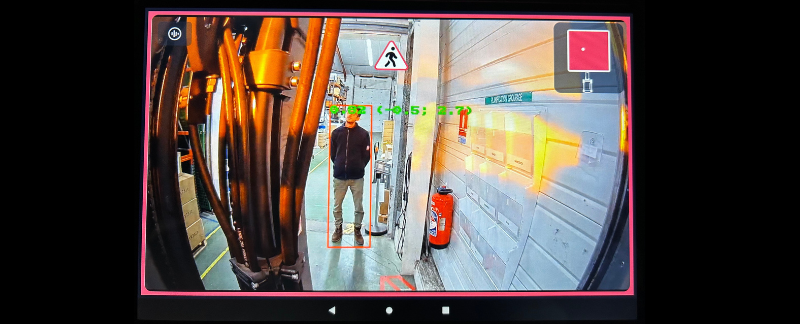AI-Based Collision Avoidance Systems: The Future of Industrial Safety
Artificial intelligence is reshaping safety practices in industrial environments. As machinery and workflows become more complex and fast-paced, traditional safety mechanisms are no longer sufficient to prevent accidents involving human workers and moving equipment.
AI-based collision avoidance systems are emerging as a transformative solution that not only detects potential collisions in real time but also intelligently distinguishes between pedestrians and inanimate objects, allowing for more accurate alerts and timely responses.

What Are AI-Based Collision Avoidance Systems?
- AI-based collision avoidance systems are advanced safety solutions designed to prevent accidents between industrial machinery and nearby pedestrians or obstacles. They combine machine vision, deep learning algorithms, and real-time data processing to identify hazardous situations and alert machine operators instantly.
- These systems are commonly installed on equipment such as forklifts, loaders, excavators, dumpers, bulldozers, compactors and other heavy-duty vehicles. They continuously guard the vehicle’s surroundings and detect pedestrians or obstacles in real time, dramatically reducing the risk of accidents in busy, dynamic environments like warehouses, factories, construction sites, quarries and mining operations.
Why AI Is Transforming Collision Avoidance
Artificial intelligence introduces a level of intelligence and precision that older technologies simply cannot match.
- Object Classification, Not Just Detection: AI systems go beyond merely detecting an object—they can classify it as a pedestrian, another vehicle, a pole, a wall, or other specific obstacles. This minimizes unnecessary alarms and ensures that alerts are meaningful.
- Adaptive Learning: AI algorithms can learn and adapt to dynamic environments, improving their accuracy over time.
- Safety Data Generation: These systems generate valuable data for audits, compliance tracking, and employee training initiatives.
A prime example of this technological evolution is Blaxtair, a pioneering AI-based collision avoidance system that is trusted worldwide to enhance workplace safety through intelligent detection and reporting
How Do AI Collision Avoidance Systems Work?
At their core, AI collision avoidance systems integrate several key components:
- Sensors / Cameras: High-resolution cameras or sensors capture detailed visual and spatial data around the machine.
- AI Processing Unit: The brain of the system, it processes the input from sensors and uses deep learning algorithms to detect and recognize pedestrians in real time.
- Alert Mechanism: If a pedestrian is detected in a danger zone, the system triggers immediate audio-visual alerts for the operator, enabling quick, corrective action.
- Data Logging Module: Every detection and near-miss incident is logged, providing valuable data for risk analysis, incident reports, safety audits, and continuous improvement.

Key Advantages Over Traditional Systems
Traditional radar- or ultrasound-based collision avoidance systems often struggle with distinguishing objects from people, leading to frequent false alarms that desensitize operators. In contrast, AI-based solutions like Blaxtair offer:
- Minimized False Positives: Accurate human recognition instills greater trust in operators.
- Predictive Safety: Historical detection data helps predict and prevent future accidents.
- Operator Engagement: Clear, meaningful alerts ensure operators remain vigilant without feeling overwhelmed.
Blaxtair’s collision avoidance technology empowers companies to transition from reactive to proactive safety management.
Real-World Use Cases Across Industries
AI collision avoidance systems have found success across a wide range of industries:
- Warehouses: Forklift-related accidents are significantly reduced by detecting workers crossing aisles or hidding behind shelves.
- Mines & Quarries: In harsh conditions, with dust and low visibility, where radar and ultrasound struggle, AI-based vision excels by maintaining detection accuracy.
- Public Works & Construction: Mobile machinery often operates near pedestrian workers in dynamic environments. AI ensures precise detection even in crowded, changing settings.
The Blaxtair integrated cloud-based IoT (Internet of Things) fleet management solution helps operations improve productivity and significantly increase the safety of people near machines. The risk of accidents can be reduced by a factor of 3.
How to Choose the Right Collision Avoidance System
Organizations looking to invest in AI-based safety should consider several factors when selecting a system.
- Pedestrian Differentiation: Does the system reliably distinguish humans from other objects?
- Performance in Challenging Environments: Can it operate in dust, rain, fog, low-visibility conditions and complex terrains?
- Fleet Integration: Is it compatible with existing machinery and safety protocols?
- Data Capabilities: Does it store incident data for analysis, reporting, and compliance?
Blaxtair excels in all these areas, making it a trusted partner for leading global organizations.
Future Trends: AI and the Evolution of Industrial Safety
The future of industrial safety powered by AI holds immense promise:
- Edge Computing: With faster, decentralized processing, detection and alert times will become even quicker, reducing latency to near-zero.
- System Integration: AI-based collision avoidance will increasingly integrate with fleet management software, telematics, and centralized safety dashboards for holistic oversight.
- Autonomous Heavy Equipment: AI collision detection will be critical in enabling safer semi-autonomous or fully autonomous machines.
- Predictive Analytics: Historical data will feed into machine learning models to predict potential accidents before they happen, enhancing preventive safety programs.
- Regulatory Compliance: With governments tightening workplace safety regulations, AI-driven systems will help companies meet and exceed new compliance standards.
Blaxtair: Leading the Way in AI Collision Avoidance
Blaxtair is at the forefront of this technological revolution. Its key features include:
- Embedded AI Camera: Rugged and weather-resistant, designed for the toughest industrial conditions.
- Real-Time Pedestrian Detection: Instant alerts without unnecessary noise.
- Global Reach: Deployed across 50+ countries worldwide and 2,000+ sites equipped in all industrial sectors.
- Aerospace-Grade Innovation: Developed by Arcure, leveraging legacy in aerospace safety technologies.
Blaxtair continues to evolve, setting new standards in industrial safety with every innovation.
Smarter Tech, Safer Sites
AI-based collision avoidance systems are no longer a futuristic concept—they are the new standard in industrial safety. As operations become more complex and the demand for productivity increases, relying solely on human vigilance and basic sensors is no longer sufficient. Companies that invest in AI to improve safety today are not just avoiding accidents; they are building a smart, more resilient future for their workforce and operations.
Ready to protect your people and your machines? Contact us today to schedule a live demo of Blaxtair’s AI-based collision avoidance system or request a personalized site evaluation.

